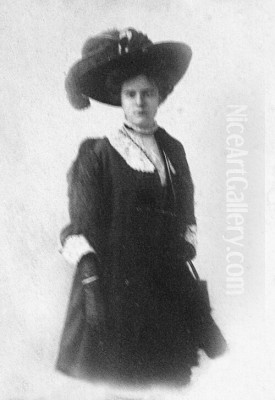
Alice Brown Chittenden (1859-1944) stands as a significant figure in the annals of American art, particularly within the vibrant artistic milieu of California during the late 19th and early 20th centuries. An accomplished painter celebrated for her exquisite floral still lifes, detailed portraits, and evocative landscapes, Chittenden not only carved out a successful career in a male-dominated field but also contributed significantly as an educator and a proponent of social change. Her life and work offer a compelling lens through which to view the artistic developments, societal shifts, and the burgeoning cultural identity of California during a transformative era.
Early Life and Artistic Formation
Born in Brockport, New York, in 1859, Alice Brown Chittenden's artistic journey began in earnest after her family relocated to the burgeoning city of San Francisco during her childhood. This move to the West Coast would prove pivotal, immersing her in a unique environment rich with natural beauty and a rapidly developing cultural scene. Her innate talent for art was evident from a young age, nurtured by a supportive family. Her father, a prosperous miner, provided the financial stability that allowed her to pursue her artistic passions, while her mother offered encouragement for her creative endeavors.
Chittenden's formal art education was undertaken at the prestigious San Francisco School of Design, which would later evolve into the California School of Design and eventually the San Francisco Art Institute (SFAI). This institution was a cornerstone of artistic training on the West Coast, and it was here that Chittenden honed her skills in drawing, painting, and particularly, the art of still life. Under the tutelage of respected instructors, she developed a meticulous technique and a keen eye for detail, qualities that would become hallmarks of her mature work. Even in these early stages, her dedication and talent set her apart, foreshadowing the significant contributions she would later make.
Artistic Style and Thematic Focus
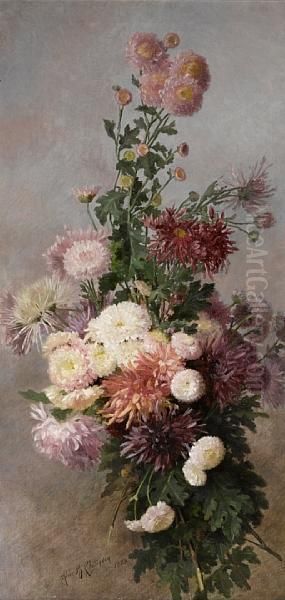
Alice Brown Chittenden's oeuvre is most renowned for its captivating floral still lifes. She possessed an extraordinary ability to capture the delicate beauty and vibrant essence of flowers, with subjects ranging from lush arrangements of roses and chrysanthemums to the diverse wildflowers native to California. Her paintings, such as the often-praised "Chrysanthemums" and "Still Life with Roses," were celebrated for their brilliant coloration, sophisticated compositions, and the almost tangible texture she imparted to petals and leaves. Critics and audiences alike lauded these works, which frequently earned her accolades and awards in numerous exhibitions.
Her style, while rooted in Realism, was infused with a delicate sensibility. Chittenden employed fine brushwork and a subtle understanding of light and shadow, often achieving a soft, almost pastel-like finish that lent an ethereal quality to her subjects. This was not merely decorative; her paintings conveyed a deep appreciation for the natural world, reflecting a meticulous observation that bordered on the scientific, yet always remained imbued with artistic grace. Beyond flowers, Chittenden was also an adept portraitist, capturing the likeness and character of her sitters with sensitivity, and a skilled landscape artist, depicting the varied scenery of California with a gentle, appreciative eye.
The Wildflowers of California: A Unique Passion
A particularly fascinating aspect of Chittenden's career was her deep engagement with the native flora of California. This interest led to a significant collaboration with the prominent botanist Alice Eastwood, who was associated with the California Academy of Sciences. Together, they embarked on expeditions to collect plant specimens. Chittenden's role extended beyond mere companionship; she meticulously created paintings and illustrations of these wildflowers, contributing to a broader project aimed at documenting the state's rich botanical diversity.
These works were more than just scientific records; they were artistic celebrations of California's unique natural heritage. Her illustrations, some of which were transformed into lantern slides for educational purposes and are reportedly still preserved, showcased the beauty and variety of plants that thrived in the Californian landscape. This collaboration highlights Chittenden's interdisciplinary interests and her commitment to capturing the essence of her adopted state. Her dedication to this subject matter aligned with a growing appreciation for regional distinctiveness in American art and science.
A Distinguished Career in Art Education
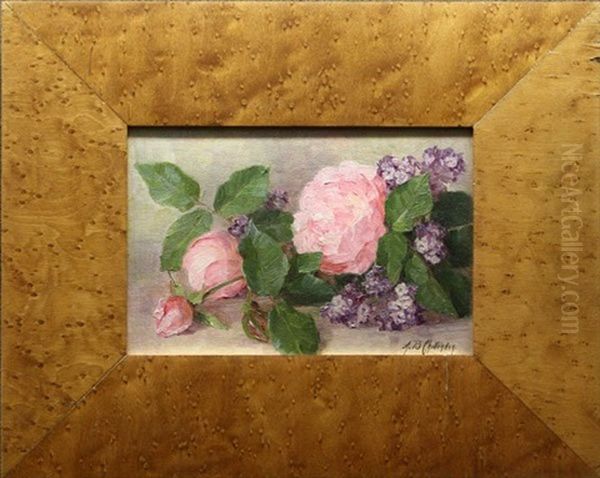
Alice Brown Chittenden's impact on the Californian art scene extended far beyond her own studio practice. She embarked on a long and influential teaching career at her alma mater, the San Francisco School of Design (later Mark Hopkins Institute of Art and then the San Francisco Art Institute). For over four decades, from 1897 to 1940, she served as a dedicated instructor, becoming the first woman to teach painting at the institution. This was a remarkable achievement at a time when academic positions for women, especially in the arts, were scarce.
Her long tenure suggests a profound commitment to nurturing new generations of artists. While specific lists of her students are not readily available in comprehensive detail, it is certain that she influenced hundreds, if not thousands, of aspiring painters during her extensive career. Her teaching likely emphasized the foundational skills of drawing and painting, a keen observation of nature, and the development of individual artistic expression – principles evident in her own work. Her dedication earned her a lifetime membership in the San Francisco Art Association (San Francisco Society of Fine Arts), a testament to her esteemed position within the artistic community.
Navigating a Man's World: Social Activism and Resilience
The late 19th and early 20th centuries presented significant challenges for women aspiring to professional careers, and the art world was no exception. Alice Brown Chittenden navigated these challenges with remarkable fortitude and a pioneering spirit. She was an active participant in social reform movements, notably the women's suffrage movement. Her involvement underscores a commitment to breaking down gender stereotypes and advocating for equal rights, not just in society at large but specifically for women in the arts.
Her personal life also reflected a degree of unconventional independence for her time. After a brief marriage, she separated from her husband and took on the responsibility of raising her daughter, Alice L. Chittenden, largely as a single parent, living with her own parents until her estranged husband's death. She never remarried, dedicating her life to her art, her teaching, and her daughter. This personal resilience, coupled with her professional achievements, positioned her as a "grande dame" among San Francisco's women artists, a figure of inspiration and respect. She famously broke a significant gender barrier by becoming one of the first women, if not the first, to have her work exhibited at the male-only Bohemian Club, a bastion of San Francisco's cultural elite.
Chittenden and Her Contemporaries
Alice Brown Chittenden's career unfolded during a dynamic period in American art, with various artistic currents shaping the national and regional scenes. In California, a distinct artistic identity was emerging, often characterized by a deep appreciation for the state's unique landscapes and light.
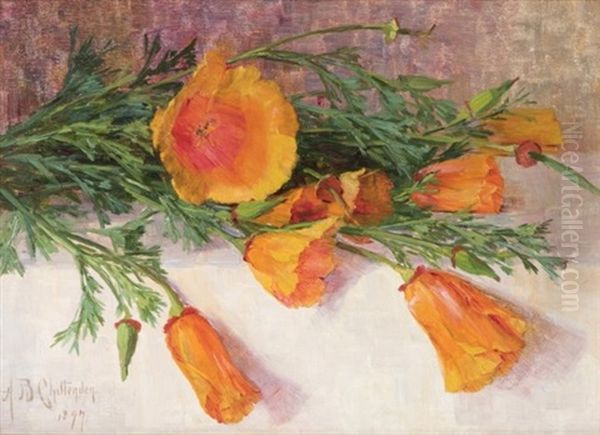
Chittenden would have been aware of, and likely interacted with, many prominent Californian artists of her era. Landscape painters like William Keith, known for his majestic depictions of California's mountains and forests, and Thomas Hill, celebrated for his grand Yosemite scenes, were dominant figures. Among women artists in California, figures such as Grace Carpenter Hudson, famed for her sensitive portrayals of the Pomo people, and Evelyn McCormick, who also painted California landscapes and flowers, were her contemporaries. Mary DeNeale Morgan, known for her Impressionistic coastal scenes and cypress trees around Carmel, and Lillie May Nicholson, who embraced an Impressionistic style for her landscapes, were also active during parts of Chittenden's career. The deaf artist Theophilus Hope d'Estrella, who taught at the California School for the Deaf and painted luminous landscapes, was another notable California artist of the period.
On a broader national and international scale, the late 19th century saw the rise of Impressionism, with American artists like Mary Cassatt and Childe Hassam adapting its principles. While Chittenden's style remained more rooted in Realism, the Impressionists' emphasis on light and color likely had some influence on the artistic atmosphere. The work of still life painters like William Merritt Chase, who was also an influential teacher, would have been part of the larger artistic discourse. Furthermore, the tradition of women botanical artists, stretching back to figures like Maria Sibylla Merian in the 17th and 18th centuries and continuing with Victorian-era artists like Marianne North, provides a historical context for Chittenden's specialization in floral subjects, though Chittenden's approach was more aligned with fine art exhibition painting than purely scientific illustration. Her contemporary, Georgia O'Keeffe, though of a younger generation and with a distinctly modernist approach, would later also bring monumental floral subjects to the forefront of American art, highlighting the enduring appeal of the theme. Chittenden's participation in exhibitions, such as those organized by the San Francisco Art Association, would have placed her work alongside that of many other artists, including individuals like Gertrude Partington Albright and Ray Bertrand, fostering a sense of community and exchange.
Exhibitions, Recognition, and Travel
Throughout her long career, Alice Brown Chittenden actively exhibited her work, gaining recognition both locally and further afield. Her paintings were regularly featured in exhibitions at the San Francisco Art Association, the California State Fair (where she won medals), and various galleries. Her reputation as a leading floral painter was solidified by consistent critical acclaim and numerous awards, including gold and silver medals for her still lifes.
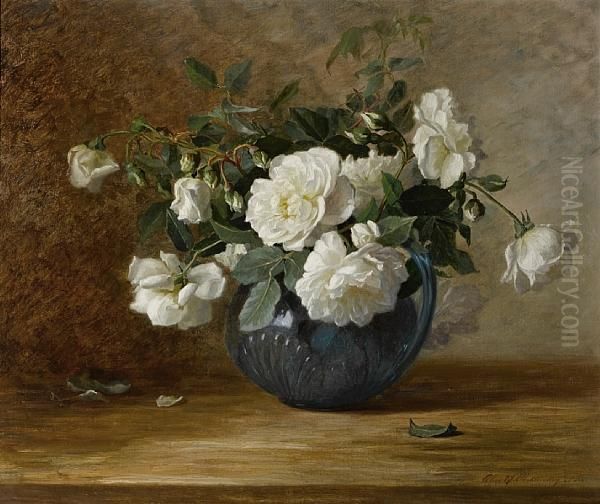
While San Francisco remained her primary base, Chittenden occasionally undertook trips to the East Coast and Europe. These journeys, which included visits to New York, France, and Italy, provided opportunities to exhibit her work to new audiences, experience firsthand the masterpieces of European art, and stay abreast of contemporary artistic developments. Such travel was crucial for artists of the period, offering invaluable exposure and inspiration. Despite these international excursions, her artistic heart remained in California, whose flora and landscapes provided her most enduring subjects. Her works found their way into significant private collections and, over time, into public institutions like the Farhat Art Museum, ensuring their preservation and continued appreciation.
Legacy and Enduring Influence
Alice Brown Chittenden passed away in 1944, leaving behind a rich legacy as an artist, educator, and pioneer. Her contributions to California art are multifaceted. As a painter, she masterfully captured the beauty of the natural world, particularly the flowers she so clearly adored. Her works are prized for their technical skill, aesthetic appeal, and their reflection of California's unique botanical heritage. They stand as testament to a refined artistic vision and a deep connection to her environment.
As an educator, her decades of service at the San Francisco Art Institute shaped countless students, instilling in them a respect for craftsmanship and a passion for artistic expression. Her role as one of the first female faculty members at such a prominent institution paved the way for future generations of women in art education.
Furthermore, Chittenden's life exemplified resilience and a quiet determination to succeed in a field where women faced considerable obstacles. Her involvement in the suffrage movement and her breaking of barriers, such as exhibiting at the Bohemian Club, underscore her commitment to equality and her role as a trailblazer.
Today, Alice Brown Chittenden is remembered as a key figure in the development of art in California. Her paintings continue to be admired in collections and at auction, and her story serves as an inspiration, particularly for those interested in the history of women in American art and the rich artistic traditions of the West Coast. Her dedication to her craft, her students, and her community has secured her a lasting place in art history. She was, in many ways, a quiet revolutionary, whose beautiful canvases spoke volumes about her talent and her unwavering spirit.